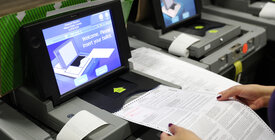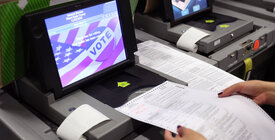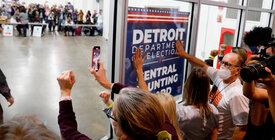
Estimated Costs for Protecting Election Workers from Threats of Physical Violence
The Brennan Center estimates that approximately $300 million is needed for key measures to keep election offices and workers physically secure for the next five years.

Part of
To view a more detailed breakdown of cost estimates, click here.
Since 2020, election officials across the country have been facing a wave of new threats. The danger demanding the most immediate attention is the rapid increase in harassment, intimidation, and threats of physical violence directed at election workers.
A recent Brennan Center survey found that one in six election officials have experienced threats because of their job, and 77 percent say that they feel these threats have increased in recent years. These risks are beginning to take a toll as experienced public servants are forced out of the profession because they fear for their safety. Thirty percent of local officials said that they knew one or more election workers who have left at least in part because of fear for their safety, increased threats, or intimidation, and 60 percent said they are concerned that such threats will make it difficult to retain and recruit election workers in future elections. One in five officials state that they are unlikely to continue to serve until the 2024 election.
Threats to election workers simply for doing their jobs represent a threat to American democracy itself. Among the many reasons is that in a system already overburdened by a lack of resources, the loss of a significant percentage of experienced workers will increase the risk of mistakes, further undermining confidence in a system that has seen a dramatic drop in public faith in recent years.
Despite the challenges they face, most election officials find real enjoyment in their jobs. It is critical to do more to make them and other election workers feel safe so the best of them remain and elections continue to work. Given the national scope of the problem, we urge the federal government to take responsibility for ensuring that states and localities have the resources they need.
Below we detail some of the increased costs that election offices across the country face as they seek to protect their workers. In total, we estimate that these important measures would cost around $300 million nationally, a relatively small price to pay given their significance to our democracy and national security.
Bulletproofing Election Offices
Total cost: $44 million to $73 million
When conspiracy-driven protesters showed up to election offices in the aftermath of the 2020 election, they didn’t just bring signs, megaphones and cameras. Many carried guns. Armed protesters were seen in front of vote counting locations in Arizona, Michigan, Nevada, and Pennsylvania, and guns also feature prominently in the threats that election officials receive.
A Wisconsin election official saw “online discussions about types of ammunition and guns to use on” her. In Vermont, a man shouted at an election official that “this might be a good time to put a f----—pistol in your f----—mouth and pull the trigger.” In Oregon, an election official looked down from her office to see the words “Vote don’t work. Next time bullets” painted in large white letters in the parking lot below.
In response to these threats and the broader increase in anti-government extremism, local governments are increasingly looking to install bullet-resistant barriers in public-facing offices. This response is not limited to the large counties and municipalities that received the most attention in 2020: Following a series of online and in-person threats, the election official in Chaffee County, Colorado — a county with a population of 19,000 — upgraded her office with bulletproof doors and glass to keep her staff safe. The Jackson County, Oregon, election official whose parking lot was painted with threatening language asked the state for about $80,000 to install bullet-resistant glass and transaction windows in the lobby and at public-facing counters in the office.
We estimate that it would cost $44 million to $73 million to install bulletproof barriers in local election offices nationwide. Actual costs could vary considerably depending on the size and age of election offices, other public functions that the office building serves, specific threats, and existing bullet-resistant barriers in place.
Panic Alarm Systems
Total cost for five years: $95 million
As stewards of democratic participation, election workers naturally hold positions that require regular interaction with the public. This includes central staff registering voters, issuing ballots, and answering questions year-round in election offices that may or may not have security features to restrict and monitor access. But it also includes poll workers serving a flood of voters in spaces that rarely have meaningful security restrictions. The risk of in-person conflict has increased for both settings and has not abated since 2020. Just this year, the election office in Nevada County, California was forced to temporarily suspend walk-up services after protesters forced their way through office doors that had been restricted under Covid-19 safety procedures.
Security experts have long recommended duress alarm systems, or “panic buttons,” for government facilities that face similar public threats, including schools, post offices, and courtrooms. Implementing these systems in election offices and polling places would allow workers to quickly and inconspicuously alert emergency personnel in the event of a security breach or other emergency.
Workers may also face threats in transit between election offices and polling places, particularly when they are carrying votes and other sensitive election materials. In these cases, their location may be unknown. Security companies now offer GPS-enabled panic buttons for these situations that allow an individual to send an alert containing their exact location with the single push of a button.
We estimate that it would cost $95 million over five years to provide panic buttons for each local election office and polling place nationwide.
Key Card Access Restrictions and Camera Surveillance
Total cost for five years: $102 million
As noted in a previous Brennan Center analysis, key card access restriction and camera surveillance systems are critical measures for safeguarding election infrastructure against insider threats. It is for this reason that states like Colorado are considering bills to require such access and monitoring of voting equipment. But these systems are also necessary for upholding the physical security of election offices.
While public access is necessary for election offices, officials can help keep staff safe by limiting the number of public entry points to the office and clearly delineating the spaces where members of the public can go to receive service. Key card access systems allow staff to use restricted entrances to the building, where they will not be followed or confronted by members of the public, and to access areas of the office where they can be isolated in the event of a security breach.
Camera surveillance is needed to monitor public and non-public areas, dissuade individuals from carrying out inappropriate behavior, and identify individuals following any incidents of intimidation or violence. Election offices should implement camera surveillance, along with adequate lighting, in interior and exterior areas, as confrontations may take place in parking lots of government facilities rather than in the office itself.
We previously estimated that it would cost $102 million nationwide for local election offices to purchase and implement access restriction and camera surveillance systems. Because this estimate focused just on restricting and monitoring access to areas with sensitive election equipment, this is likely a low-end estimate. Adequately protecting election officials may require monitoring more spaces, entry points, and exterior areas of election offices.
Personal Information Protection
Total cost for five years: $50 million
The online availability of election workers’ personal identifiable information — including home addresses and personal phone numbers — has been used by bad actors to facilitate threats, harassment, and intimidation against the workers and their families. In response, some election offices are looking to contract with outside providers that help scrub personally identifying information from the internet, conduct monthly checks to ensure that information does not return, and offer tailored guidance on how to protect personal information in the future.
We estimate that it would cost $50 million over five years for each local election office nationwide to purchase such services for one to three of the office’s highest profile employees.
• • •
This is by no means an exhaustive list of the additional costs state and local governments will face as they seek to protect their election workers from threats, harassment, and violence. Election offices may need to hire security to protect workers during periods when public attention is highest, which could cost tens of thousands of dollars per jurisdiction over the next two election cycles. Some jurisdictions are facing higher insurance costs to cover their polling places following the January 6 riots and insurance companies’ perceptions on the risk of political tensions leading to violence. And many election officials need resources to improve security at their homes, with items such as doorbell cameras and home security system subscriptions, as threats and intimidation have not been limited to these officials’ places of work.
Nevertheless, it should be clear that for a relatively minimal investment the federal government could make significant progress in protecting the most important election resource we have: the tens of thousands of workers who are necessary for our elections to succeed.
More from the Election Infrastructure Costs collection
-
Estimated Costs for Protecting Election Infrastructure Against Insider Threats
We estimate that the nationwide five-year cost for basic security measures is approximately $316 million dollars. -
Costs for Replacing Voting Equipment in 2024
While states continue to make progress in updating their voting equipment, additional funding for election security is needed. -
Estimated Costs for Protecting Election Workers from Threats of Physical Violence
The Brennan Center estimates that approximately $300 million is needed for key measures to keep election offices and workers physically secure for the next five years.




